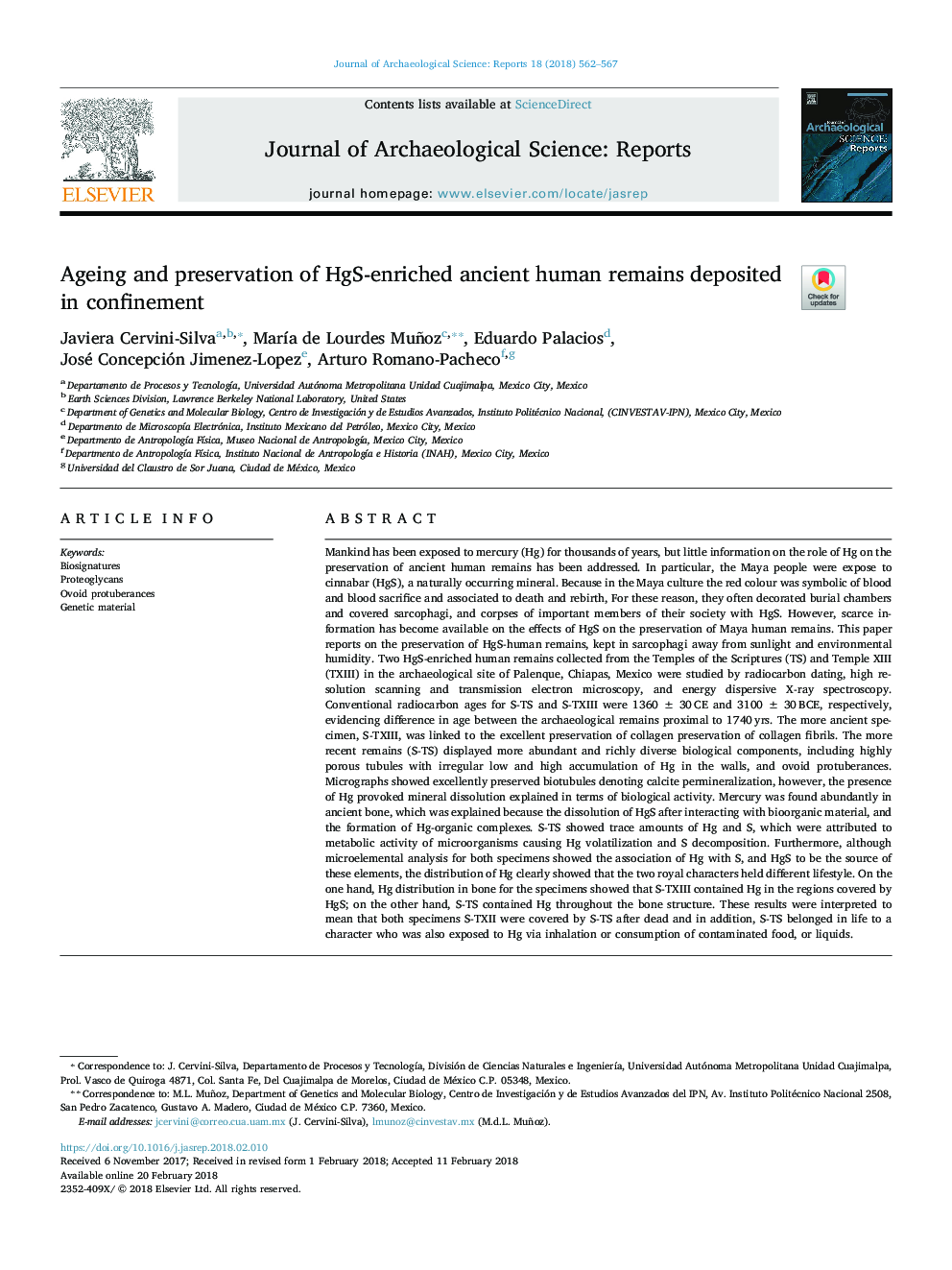| کد مقاله | کد نشریه | سال انتشار | مقاله انگلیسی | نسخه تمام متن |
|---|---|---|---|---|
| 7445087 | 1483925 | 2018 | 6 صفحه PDF | دانلود رایگان |
عنوان انگلیسی مقاله ISI
Ageing and preservation of HgS-enriched ancient human remains deposited in confinement
دانلود مقاله + سفارش ترجمه
دانلود مقاله ISI انگلیسی
رایگان برای ایرانیان
موضوعات مرتبط
علوم انسانی و اجتماعی
علوم انسانی و هنر
تاریخ
پیش نمایش صفحه اول مقاله

چکیده انگلیسی
Mankind has been exposed to mercury (Hg) for thousands of years, but little information on the role of Hg on the preservation of ancient human remains has been addressed. In particular, the Maya people were expose to cinnabar (HgS), a naturally occurring mineral. Because in the Maya culture the red colour was symbolic of blood and blood sacrifice and associated to death and rebirth, For these reason, they often decorated burial chambers and covered sarcophagi, and corpses of important members of their society with HgS. However, scarce information has become available on the effects of HgS on the preservation of Maya human remains. This paper reports on the preservation of HgS-human remains, kept in sarcophagi away from sunlight and environmental humidity. Two HgS-enriched human remains collected from the Temples of the Scriptures (TS) and Temple XIII (TXIII) in the archaeological site of Palenque, Chiapas, Mexico were studied by radiocarbon dating, high resolution scanning and transmission electron microscopy, and energy dispersive X-ray spectroscopy. Conventional radiocarbon ages for S-TS and S-TXIII were 1360â¯Â±â¯30â¯CE and 3100â¯Â±â¯30â¯BCE, respectively, evidencing difference in age between the archaeological remains proximal to 1740â¯yrs. The more ancient specimen, S-TXIII, was linked to the excellent preservation of collagen preservation of collagen fibrils. The more recent remains (S-TS) displayed more abundant and richly diverse biological components, including highly porous tubules with irregular low and high accumulation of Hg in the walls, and ovoid protuberances. Micrographs showed excellently preserved biotubules denoting calcite permineralization, however, the presence of Hg provoked mineral dissolution explained in terms of biological activity. Mercury was found abundantly in ancient bone, which was explained because the dissolution of HgS after interacting with bioorganic material, and the formation of Hg-organic complexes. S-TS showed trace amounts of Hg and S, which were attributed to metabolic activity of microorganisms causing Hg volatilization and S decomposition. Furthermore, although microelemental analysis for both specimens showed the association of Hg with S, and HgS to be the source of these elements, the distribution of Hg clearly showed that the two royal characters held different lifestyle. On the one hand, Hg distribution in bone for the specimens showed that S-TXIII contained Hg in the regions covered by HgS; on the other hand, S-TS contained Hg throughout the bone structure. These results were interpreted to mean that both specimens S-TXII were covered by S-TS after dead and in addition, S-TS belonged in life to a character who was also exposed to Hg via inhalation or consumption of contaminated food, or liquids.
ناشر
Database: Elsevier - ScienceDirect (ساینس دایرکت)
Journal: Journal of Archaeological Science: Reports - Volume 18, April 2018, Pages 562-567
Journal: Journal of Archaeological Science: Reports - Volume 18, April 2018, Pages 562-567
نویسندگان
Javiera Cervini-Silva, MarÃa de Lourdes Muñoz, Eduardo Palacios, José Concepción Jimenez-Lopez, Arturo Romano-Pacheco,